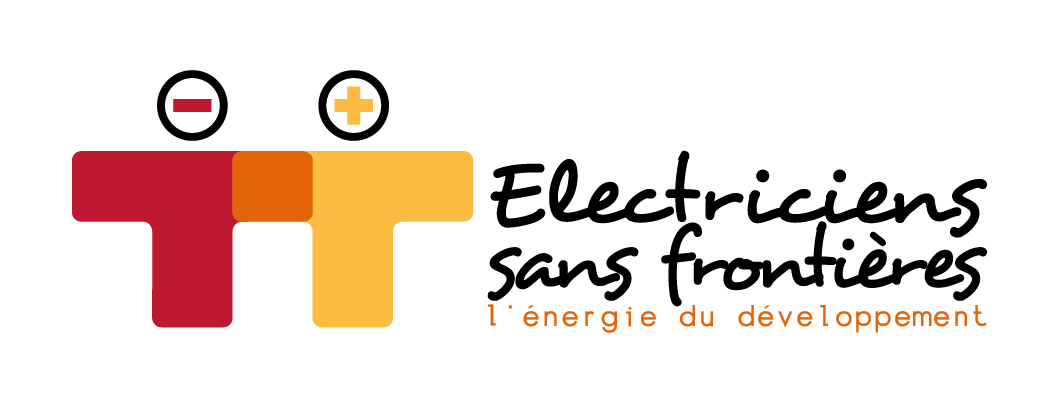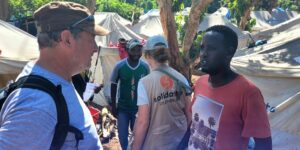Alternatives Humanitaires, Article – Author : Claire Desoubry
Non-governmental organizations are no exception to the need to reduce our carbon footprint. In France, around ten of them have already taken concrete steps in this direction.
Climate change due to human activities[1] affects the frequency and intensity of extreme weather events (droughts, floods, cyclones, etc.). As climate change continues, each region of the world will experience more extreme weather events, sometimes combined, with multiple consequences. Recent years have shown that this movement is underway. And the higher the degree of warming, the more we’ll be affected, with the 1.5°C limit now looking unlikely. Moreover, current policies (if they are adhered to) predict an increase of 2.8°C by the end of the century.[2].
Although they spare no part of our planet, these extreme events more frequently impact countries in the “South”. The consequences are severe, adding to and exacerbating existing structural weaknesses. They thus accentuate a state of permanent and prolonged crisis, where emergencies are becoming the norm: epidemics, food insecurity, malnutrition, forced displacement. More than one hundred million Africans will be directly threatened by global warming and its impacts by 2030.[3]. Climate and environmental crises lead to the degradation of ecosystems and incalculable damage to human infrastructures. As a result, they multiply the risks of food insecurity and water shortages, and jeopardize the progress made in development.
“A growing number of humanitarian and development organizations around the world have pledged to take greater account of climate and environmental issues in their response to needs.”
Faced with these facts, the aid sector has decided to mobilize and adapt its practices. Over the past two years, a growing number of humanitarian and development organizations around the world have pledged to take greater account of climate and environmental issues in their response to needs. They have done so through the Charter on Climate and the Environment for humanitarian organizations.[4]. In France, ten non-governmental organizations (NGOs)[5] also adopted in December 2020, on the occasion of the National Humanitarian Conference, a Declaration of Commitment by Humanitarian Organizations on Climate[6]. Their aim is to measure and reduce their impact to ensure that their activities cause as little harm as possible to the environment (greenhouse gas emissions [GES], waste and pollution, consumption of scarce natural resources).
Some figures to understand greenhouse gas emissions (2019 data)
→ The whole world generates 59,100 million tonnes (Mt) of CO2 equivalent,
→ including 3,600 Mt CO2 equivalent for the European Union alone,
→ including 436 Mt CO2 equivalent for France.
→ An NGO like Electriciens sans frontières generates 860 tonnes (t) of CO2 equivalent.
→ In France, each inhabitant generates 9.9 t CO2 equivalent :
- three main items: travel (especially by car), food (meat) and housing (depending on heating);
This is an average for France as a whole, half of France’s footprint being linked to the population (20%), given that half the population is responsible for only 20% of emissions.
Examples of emissions and reductions:
- Flight Paris – Tananarive (Madagascar) = 2.6 t CO2 equivalent
- Paris – Dakar (Senegal) = 1.3 t CO2 equivalent
- Meat diet (red meat) = 4.6 t CO2 equivalent/ vegetarian diet = 0.3 t CO2 equivalent
- 300 Wp solar panel (watt-peak, the unit used to measure the maximum power a solar panel is capable of delivering under ideal conditions)
- produced in China = 321 kg CO2 equivalent
- produced in France = 185 kg CO2 equivalent.
For Electriciens sans frontières, purchasing 100% of its solar panels from the supplier with the lowest carbon footprint on the market means a 63% reduction in emissions linked to the purchase of its solar panels, and a 15% reduction in its overall carbon footprint.
First steps towards a carbon footprint
Most of these NGOs – since joined by others – have decided to join forces in a common working group on the issue, within the Humanitarian Environment Network (REH). This is a group for exchanging and sharing best practices on integrating climate and environmental issues into aid projects, a group of which Electriciens sans frontières has been an active member since its creation in 2012.
To pool costs, a service provider common to all these NGOs, the Centre interprofessionnel technique d’études de la pollution atmosphérique (CITEPA), was contracted to help set up a carbon approach. An analysis of the need and the relevant scope, by NGO, enabled each to draw its own conclusions, to have a vision of the most important items, of the data to be collected internally to carry out a carbon footprint, and of the human and financial resources required to do so each year. An initial carbon assessment has also been carried out for each of the associations.
Although this first estimate was not perfectly exhaustive (some data is missing or estimated), it clearly highlights the two main GHG emission items for Electriciens sans frontières in 2019 (chosen as the reference year, as the years impacted by Covid-19 are not very representative). The first (50%) is linked to the NGO’s purchases for its projects (solar panels, batteries, etc.), while the second (40%) concerns air travel.
Internalizing issues
This collective effort coincides with the formalization of an internal environmental policy at Electriciens sans frontières. The organization’s commitment to these issues is not new, since its projects have long promoted the use of renewable energies as opposed to polluting fossil fuels with high GHG emissions. In addition, it helps other international solidarity organizations to adopt renewable energies to power their global offices and humanitarian projects, thereby helping to reduce their carbon footprint. In 2009, an Open Source Excel tool had already been developed to generate CO2 balances for projects and regional delegations (operations), encouraging less carbon-intensive choices.
In order to set up an internal climate and carbon approach, supported from the outset by the NGO’s management, Electriciens sans frontières recruited one person and mobilized another employee (equivalent to 0.7 FTE) for one year, within its team of eleven employees. To carry out their carbon footprint, organizations have two options: hire an external service provider or bring the subject in-house. Electriciens sans frontières has therefore opted for the latter. Trained as engineers, the two people involved took the Bilan Carbone® training course run by the Association pour la Transition Bas Carbone (ABC).[7]The NGO also benefited from the expertise of a volunteer who specializes in carbon assessment due to his professional activity.
The association began by appropriating the work carried out by CITEPA and distributing a summary of it to its governing bodies and its salaried and volunteer teams, via internal communication channels. It then set about implementing a carbon footprint as proposed by ABC. This method is divided into five stages: appointment of a pilot and definition of objectives, definition of the scope to be accounted for, data collection and processing, definition of a reduction action plan, and a summary of the process. The aim of a carbon footprint is to identify the sources of GHG emissions in order to assess and reduce an organization’s real impact.
At the same time, awareness-raising initiatives have been launched in response to the following challenges: to bring about changes in an organization’s practices, it is essential that everyone shares the importance of the issues at stake, feels concerned and understands the role they can play. In addition, Electricians Without Borders projects are designed, built and implemented by volunteer experts from a pool of 1,200 members in fourteen regional delegations.[8]. Raising awareness is therefore essential, not only among head office staff and management bodies.
To this end, presentations were made to the association’s three commissions (project management, communications and partnerships, treasury), which bring together the volunteer regional secretariats of the fourteen delegations (forty-two members), as well as to the governance and administrative boards. These presentations, lasting around an hour, clarified key concepts: why is the NGO concerned by climate and carbon issues? What does a carbon approach entail? What are the initial results? What are the association’s ambitions for the future? They also enabled us to identify existing questions or concerns. Climate Frescoes[9] were produced remotely with the appropriate tools for each regional secretariat. Fresco animators have been identified among the volunteers to continue the face-to-face workshops in the regional delegations. An interactive webinar was organized for all Electriciens sans frontières volunteers, and the recording remains available for viewing on the association’s shared platforms. Finally, a summary of the six key points on climate change and carbon footprint at Electriciens sans frontières has been drawn up to serve as an internal reference.
Feedback shows the need to understand the stakes upstream of the commitment. Several participants, initially unconvinced by the approach, said they understood better why carbon and climate issues were raised after a constructive presentation of the issues and the association’s position. Another major issue concerns the means of taking action at NGO level: decarbonizing projects, influencing equipment suppliers, convincing donors of the relevance of more expensive but less carbon-intensive services.
Calculation of 2022 emissions and identification of reduction actions
Carrying out a carbon footprint can be a time-consuming process, given the difficulty of gathering data and the lack of allocated resources. It is crucial to have reliable orders of magnitude for the emissions linked to one’s activity in order to avoid erroneous conclusions. For example, an organization might underestimate the impact of its waste, use or end-of-life products, believing that these emissions are negligible (until July 2022, these emission categories were not mandatory under the regulation).[10]). However, there’s no need to wait for results down to the nearest kilogram of CO2 equivalent before starting to implement reduction actions, as the carbon footprint is not an end in itself. The real objective is to be able to implement effective reduction actions for the organization’s major emission sources.
“The real objective is to be able to implement effective reduction actions with regard to the organization’s major emission sources.
To facilitate data collection and estimate GHG emissions, Electricians Without Borders has created a simplified tool. It enables volunteer teams to identify project-related GHG emissions by recording details of equipment used (type, weight, etc.), field missions carried out (number of participants, kilometers covered, etc.) and freight (departure and arrival ports, tonnage transported, etc.). The aim is also to make teams aware of the orders of magnitude involved, and to gradually integrate proposals for alternative actions to reduce the associated GHG emissions upstream, during project construction. This tool will be deployed by the end of 2023.
To reduce its emissions, the NGO decided to start with the two main contributors: purchasing and air travel. For the former, the aim is to identify the equipment most responsible for GHG emissions. The most likely solutions to date are to turn to suppliers offering materials that are less carbon-intensive than those used today: solar panels produced in Asia using carbon-based energy sources (coal, oil, gas, etc.) are a good example.[11]In some European countries, for example, we prefer to use more carbon-free energy sources (solar, hydraulic, etc.). However, other avenues remain to be explored, such as recycling and end-of-life issues, ever more precise optimization of photovoltaic installations, and so on.
For air travel, a study of the current situation is required. Certain measures aimed at reducing the number of flights are already in use, such as pooling travel for missions in the same geographical area. The first objective is therefore to generalize these existing good practices. Electricians Without Borders is taking a rigorous approach to this exercise and, beyond more or less short-term actions, is allowing itself to question its current operating model: the possibility of limiting long-distance travel, the possibility of opening local offices. Questioning the way things work is essential to exploring real solutions. The ecological and social transition needed today will not be achieved without changing the system we live in, and NGOs and all other organizations must also ask themselves whether their operations are sustainable and relevant.
Challenges, limits and learning
But climate change is not the only challenge to consider. It’s not uncommon, when working on this theme, to overlook other important, fundamentally related issues, such as the availability of water resources or biodiversity. The same applies to social and societal issues, in which international solidarity organizations are particularly involved.
This is our first challenge: to improve our environmental practices while preserving the raison d’être of Electriciens sans frontières. In fact, the association works in areas where others (notably companies and governments) don’t go, mainly isolated rural areas, to contribute to local development. Tackling environmental and climate issues requires major structural changes that call into question our entire business. Each organization has its own path built in response to the challenges it has encountered. But the climate challenge is undoubtedly the most important one it will have to face over the coming decades.
Tackling all these issues can be daunting. Climate concerns aside, change remains a complex challenge for organizations and individuals alike. So it’s an ambitious task to support employees and volunteers in understanding and mastering environmental, climatic and societal issues.
One might then think that Electricians Without Borders would have chosen to perpetuate a salaried position on the subject or to increase the initial work time devoted to it. This is not the decision that has been taken, even if the NGO’s desire – widely supported by its governing bodies – is to continue making progress in this area. To this end, it has opted to set up an in-house climate working group, drawing on its living resource of volunteers, in line with its model, while retaining 0.25 FTE salaried support. This working group is organized along three lines: calculation and estimation of emissions (carrying out internal carbon balances, estimating and monitoring reduction measures); awareness-raising (to continue to ensure that NGO members fully understand the issues and reduction measures); and action plan (study, costing and monitoring of reduction actions or potential structural changes for the association’s future). Although the NGO wishes to evolve rapidly, its current resources and operating model do not allow it to adopt an organization radically different from that described above.
The NGO cannot act alone. For example, it needs photovoltaic players to offer decarbonized products, which will become the norm, rather than a marginal offering. It must continue to collaborate with the other NGO stakeholders in the networks of which it is a part, in order to pool resources, needs, ideas and solutions. It needs new resources and the support of its backers to take into account these less carbon-intensive alternatives, which are often more costly and time-consuming. Recognizing that it cannot change the world on its own, the NGO is also counting on governments, businesses and citizens to take action against global warming, whether through mitigation or adaptation.
Electriciens sans frontières hopes to use this feedback to transparently share its approach to integrating climate issues into its business, the path it has taken, the difficulties it has encountered and its determination to continue along this path – which is still long and complex.
| ↑1 | IPCC, AR6 Climate Change 2021: The Physical Science Basis, August 2021, https://www.ipcc.ch/reports |
| ↑2 | UNEP, Emissions Gap Report 2022: The Closing Window – Climate crisis calls for rapid transformation of societies, October 2022, https://www.unep.org/emissions-gap-report-2022 |
| ↑3 | Le Monde with AFP, ” Plus de 100 millions d’Africains menacés par le réchauffement climatique d’ici à 2030, selon l’ONU “, October 19, 2021, https://www.lemonde.fr/afrique/article/2021/10/19/plus-de-100-millions-d-africains-menaces-par-le-rechauffement-climatique-d-ici-a-2030-selon-l-onu_6099004_3212.html |
| ↑4 | ICRC, Climate and Environment Charter for Humanitarian Organizations, June 14, 2021, https://www.climate-charter.org/wp-content/uploads/2021/12/ClimateEnvironmnentCharter-FR.pdf |
| ↑5 | Action contre la Faim, Handicap International, Electriciens sans frontières, Croix-Rouge française, Médecins du Monde, Première Urgence Internationale, Oxfam, Secours Islamique France, Solidarités International and CARE. |
| ↑6 | Humanitarian Environment Network, Declaration of commitment by humanitarian organizations on climate, December 2020, https://www.urd.org/wp-content/uploads/2023/07/DeclarationEngagementONGClimat_2023.pdf |
| ↑7 | Visit the association’s website: https://abc-transitionbascarbone.fr |
| ↑8 | To find out more about our regional offices in France: https://electriciens-sans-frontieres.org/nos-delegations-regionales-en-france |
| ↑9 | Association la Fresque du Climat, https://fresqueduclimat.org |
| ↑10 | Ministère de la Transition écologique et de la Cohésion des territoires, Décret bilan des émissions de gaz à effet de serre (BEGES), July 11, 2022, https://www.ecologie.gouv.fr/decret-bilan-des-emissions-gaz-effet-serre-beges |
| ↑11 | The GHG emissions associated with the purchase of a solar panel are largely due to the energy used in certain energy-intensive manufacturing processes. The term “energy mix” is also used to designate the distribution of the different primary energy sources used to meet the needs of a given country or region (examples can be found at: https://www.iea.org/countries). |



